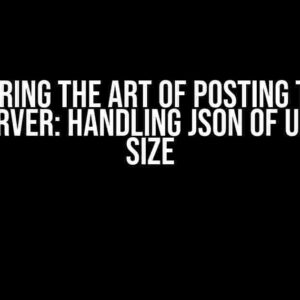Are you tired of duplicating code across multiple pages just to reuse a simple dialog box? Do you dream of a world where you can create a single, reusable HTML dialog element that can be effortlessly shared across your entire website?
Well, buckle up, friend, because today we’re going to explore the magical world of HTML modularity and learn how to reuse an HTML dialog element across pages like a pro!
The Problem: Code Duplication and Maintenance Nightmares
We’ve all been there: creating a beautiful, functional dialog box on one page, only to realize we need to duplicate the code on multiple pages. Ugh, the thought alone gives me the chills!
The consequences of code duplication are real:
- Maintenance headaches: Updating the dialog box on one page means updating it on every page, which can be a daunting task.
- Higher page load times: Duplicating code means increased file sizes, leading to slower page loads.
- Decreased code readability: Copied code can become a tangled mess, making it difficult to understand and debug.
The Solution: Modular HTML Dialog Elements
By creating a reusable HTML dialog element, we can:
- Simplify maintenance: Update the dialog box in one place, and it’s instantly reflected across all pages.
- Improve page load times: Reduce code duplication, resulting in smaller file sizes and faster page loads.
- Boost code readability: Modular code is cleaner, easier to understand, and more maintainable.
Step 1: Create a Separate HTML File for the Dialog Element
Let’s create a new HTML file called `dialog.html` that will contain our reusable dialog element.
<!-- dialog.html --> <dialog id="myDialog"> <h2>My Dialog Box</h2> <p>This is my reusable dialog box!</p> <button>Close</button> </dialog>
Step 2: Use the HTML Import Feature
Now, let’s import our `dialog.html` file into our main HTML file using the HTML import feature.
<!-- main.html --> <link rel="import" href="dialog.html">
Step 3: Use JavaScript to Load the Dialog Element
We’ll use JavaScript to load the dialog element and make it accessible across all pages.
<!-- main.html -->
<script>
const dialogHTML = document.querySelector('link[rel="import"]').import.querySelector('#myDialog');
document.body.appendChild(dialogHTML);
</script>
Step 4: Show and Hide the Dialog Element
Let’s add some JavaScript to show and hide the dialog element on demand.
<!-- main.html -->
<script>
const dialog = document.querySelector('#myDialog');
const showDialog = () => {
dialog.showModal();
};
const hideDialog = () => {
dialog.close();
};
// Example button to show the dialog
const btn = document.createElement('button');
btn.textContent = 'Show Dialog';
btn.onclick = showDialog;
document.body.appendChild(btn);
// Example button to hide the dialog
const closeBtn = dialog.querySelector('button');
closeBtn.onclick = hideDialog;
</script>
Best Practices for Reusing HTML Dialog Elements
To get the most out of your reusable HTML dialog element, follow these best practices:
- Keep it simple: Avoid adding complex logic or excessive styling to your dialog element.
- Use semantic HTML: Use HTML elements that provide meaning to the structure of your dialog element, such as `
` for headings and `
` for paragraphs.
- Separate concerns: Keep your dialog element separate from your main HTML file to maintain modularity and ease of maintenance.
- Test and iterate: Thoroughly test your dialog element and make adjustments as needed to ensure it works smoothly across all pages.
Conclusion: Unlocking the Power of Modularity
By following these steps and best practices, you can create a reusable HTML dialog element that can be effortlessly shared across your entire website, reducing code duplication, improving page load times, and boosting code readability.
So, go ahead and unlock the power of modularity in your HTML projects. Your future self (and your users) will thank you!
| Before | After |
|---|---|
| Code duplication across multiple pages | Modular, reusable HTML dialog element |
| Maintenance nightmares | Simplified maintenance and updates |
| Higher page load times | Faster page loads and improved performance |
Ready to take your HTML skills to the next level? Dive deeper into the world of modularity and explore the endless possibilities of reusable HTML elements!
Frequently Asked Question
Get ready to unlock the secret to reusing HTML Dialog elements across pages like a pro!
Q1: What is the main challenge in reusing an HTML Dialog element across pages?
The main challenge is that HTML Dialog elements are tightly coupled with their parent page, making it difficult to reuse them across multiple pages without duplicating code or creating a mess!
Q2: Can I use JavaScript to dynamically create and append the Dialog element to each page?
Yes, you can use JavaScript to dynamically create and append the Dialog element to each page. However, this approach can lead to code duplication and maintenance headaches. Instead, consider using a template engine or a framework that supports component-based architecture.
Q3: How can I decouple the Dialog element from its parent page to make it reusable?
To decouple the Dialog element, you can extract it into a separate HTML file or a template, and then use JavaScript to load and initialize it on each page. This way, you can maintain a single copy of the Dialog element and reuse it across multiple pages.
Q4: What are some best practices for reusing HTML Dialog elements across pages?
Some best practices include: using a modular architecture, separating concerns, and keeping the Dialog element self-contained. Additionally, consider using a consistent naming convention and organizing your code in a way that makes it easy to find and reuse the Dialog element.
Q5: Are there any frameworks or libraries that can help me reuse HTML Dialog elements across pages?
Yes, there are several frameworks and libraries that can help you reuse HTML Dialog elements across pages, such as Web Components, Angular, React, and Vue.js. These frameworks provide built-in support for component-based architecture and can help you write more maintainable and reusable code.





